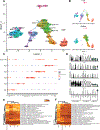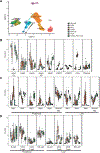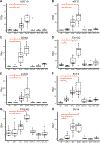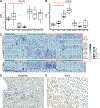Gene Deconvolution Reveals Aberrant Liver Regeneration and Immune Cell Infiltration in Alcohol-Associated Hepatitis
- PMID: 33619773
- PMCID: PMC8475730
- DOI: 10.1002/hep.31759
Gene Deconvolution Reveals Aberrant Liver Regeneration and Immune Cell Infiltration in Alcohol-Associated Hepatitis
Abstract
Background and aims: Acute liver damage causes hepatocyte stress and death, but in chronic liver disease impaired hepatocyte regeneration and immune cell infiltration prevents recovery. While the roles of both impaired liver regeneration and immune infiltration have been studied extensively in chronic liver diseases, the differential contribution of these factors is difficult to assess.
Approach and results: We combined single-cell RNA-sequencing (RNA-seq) data from healthy livers and peripheral immune cells to measure cell proportions in chronic liver diseases. Using bulk RNA-seq data from patients with early alcohol-associated hepatitis, severe AH (sAH), HCV, HCV with cirrhosis, and NAFLD, we performed gene deconvolution to predict the contribution of different cell types in each disease. Patients with sAH had the greatest change in cell composition, with increases in both periportal hepatocytes and cholangiocyte populations. Interestingly, while central vein hepatocytes were decreased, central vein endothelial cells were expanded. Endothelial cells are thought to regulate liver regeneration through WNT signaling. WNT2, important in central vein hepatocyte development, was down in sAH, while multiple other WNTs and WNT receptors were up-regulated. Immunohistochemistry revealed up-regulation of FZD6, a noncanonical WNT receptor, in hepatocytes in sAH. Immune cell populations also differed in disease. In sAH, a specific group of inflammatory macrophages was increased and distinct from the macrophage population in patients with HCV. Network and correlation analyses revealed that changes in the cell types in the liver were highly correlated with clinical liver function tests.
Conclusions: These results identify distinct changes in the liver cell populations in chronic liver disease and illustrate the power of using single-cell RNA-seq data from a limited number of samples in understanding multiple different diseases.
© 2021 by the American Association for the Study of Liver Diseases.
Conflict of interest statement
Declaration Competing of Interest
The authors declare that they have no competing of interest.
Figures





Comment in
-
A Beautiful Day in the Neighborhood: Application of Single-Cell Transcriptomics to Unravel Liver Cell Heterogeneity in Diseased Human Livers.Hepatology. 2021 Aug;74(2):547-549. doi: 10.1002/hep.31827. Epub 2021 May 28. Hepatology. 2021. PMID: 33756021 Free PMC article. No abstract available.
References
Publication types
MeSH terms
Grants and funding
LinkOut - more resources
Full Text Sources
Other Literature Sources

